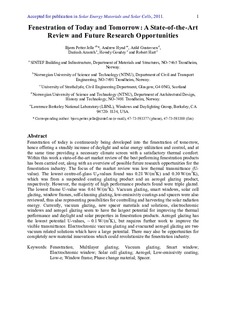| dc.contributor.author | Jelle, Bjørn Petter | |
| dc.contributor.author | Hynd, Andrew | |
| dc.contributor.author | Gustavsen, Arild | |
| dc.contributor.author | Arasteh, Dariush | |
| dc.contributor.author | Goudey, Howdy | |
| dc.contributor.author | Hart, Robert | |
| dc.date.accessioned | 2017-10-05T10:50:53Z | |
| dc.date.available | 2017-10-05T10:50:53Z | |
| dc.date.created | 2011-10-14T13:46:07Z | |
| dc.date.issued | 2012 | |
| dc.identifier.citation | Solar Energy Materials and Solar Cells. 2012, 96 (1), 1-28. | nb_NO |
| dc.identifier.issn | 0927-0248 | |
| dc.identifier.uri | http://hdl.handle.net/11250/2458658 | |
| dc.description.abstract | Fenestration of today is continuously being developed into the fenestration of tomorrow, hence offering a steadily increase of daylight and solar energy utilization and control, and at the same time providing a necessary climate screen with a satisfactory thermal comfort. Within this work a state-of-the-art market review of the best performing fenestration products has been carried out, along with an overview of possible future research opportunities for the fenestration industry. The focus of the market review was low thermal transmittance (U-value). The lowest centre-of-glass Ug-values found was 0.28 and 0.30 W/m2 K, which was from a suspended coating glazing product and an aerogel glazing product, respectively. However, the majority of high performance products found were triple glazed. The lowest frame U-value was 0.61 W/m2 K. Vacuum glazing, smart windows, solar cell glazing, window frames, self-cleaning glazing, low-emissivity coatings and spacers were also reviewed, thus also representing possibilities for controlling and harvesting the solar radiation energy. Currently, vacuum glazing, new spacer materials and solutions, electrochromic windows and aerogel glazing seem to have the largest potential for improving the thermal performance and daylight and solar properties in fenestration products. Aerogel glazing has the lowest potential U-values, ∼0.1 W/m2 K, but requires further work to improve the visible transmittance. Electrochromic vaccum glazing and evacuated aerogel glazing are two vacuum-related solutions, which have a large potential. There may also be opportunities for completely new material innovations, which could revolutionize the fenestration industry. | nb_NO |
| dc.language.iso | eng | nb_NO |
| dc.publisher | Elsevier | nb_NO |
| dc.rights | Attribution-NonCommercial-NoDerivatives 4.0 Internasjonal | * |
| dc.rights.uri | http://creativecommons.org/licenses/by-nc-nd/4.0/deed.no | * |
| dc.title | Fenestration of Today and Tomorrow: A State-of-the-Art Review and Future Research Opportunities | nb_NO |
| dc.type | Journal article | nb_NO |
| dc.type | Peer reviewed | nb_NO |
| dc.description.version | acceptedVersion | nb_NO |
| dc.source.pagenumber | 1-28 | nb_NO |
| dc.source.volume | 96 | nb_NO |
| dc.source.journal | Solar Energy Materials and Solar Cells | nb_NO |
| dc.source.issue | 1 | nb_NO |
| dc.identifier.doi | 10.1016/j.solmat.2011.08.010 | |
| dc.identifier.cristin | 845454 | |
| dc.relation.project | Norges forskningsråd: 207551 | nb_NO |
| dc.description.localcode | © 2011. This is the authors’ accepted and refereed manuscript to the article. This manuscript version is made available under the CC-BY-NC-ND 4.0 license http://creativecommons.org/licenses/by-nc-nd/4.0/ | nb_NO |
| cristin.unitcode | 194,64,35,0 | |
| cristin.unitcode | 194,61,25,0 | |
| cristin.unitname | Institutt for bygg, anlegg og transport | |
| cristin.unitname | Institutt for byggekunst, historie og teknologi | |
| cristin.ispublished | true | |
| cristin.fulltext | original | |
| cristin.fulltext | postprint | |
| cristin.qualitycode | 2 | |

